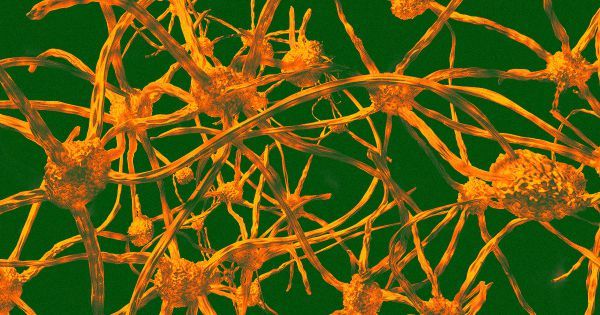Category: life extension – Page 530

Study finds that in mice, lycopene in tomatoes reduced fatty liver disease, inflammation and liver cancer
In the fight against cancer, there is a surprising tool in the arsenal: the food we eat. That’s because some nutrients in food have been found to play a role in preventing cancer, and it’s relevant because the World Cancer Research Fund reports that 30 to 50 percent of cancer cases are preventable, putting a focus on stopping cancer from developing in the first place.
Xiang-Dong Wang, a senior scientist and associate director of the Jean Mayer USDA Human Research Center on Aging at Tufts, studies how food can help prevent cancer development, particularly lung, liver, and colon cancer.
Although the rate of most cancers is dropping, there is increasing concern about the rise in both incidence and death rate of liver cancer in the United States, partially due to the parallel rise in nonalcoholic fatty liver disease, obesity, and diabetes.
CNBC — Combating Aging
Channel t-shirt: https://teespring.com/aging-reversed
Longevity and Age Reversal
Meanwhile, LIVE in Hollywood, FL today.
Brian Manning Delaney will join us with a presentation on “Navigating the Labyrinth of Dietary Restriction Methods.“
Followed with an Age Reversal Update by William Faloon.
William Faloon compiled the 1,500-page medical reference book Disease Prevention and Treatment, and his latest book is Pharmocracy: How Corrupt Deals and Misguided Medical Regulations Are Bankrupting America—and What to Do About It. He is also Director and Co-founder of the Life Extension Foundation.
To promote Life Extension’s innovative medical concepts, William Faloon has been featured in hundreds of media appearances including The Phil Donahue Show, The Joan Rivers Show, Tony Brown’s Journal, ABC News Day One, and Newsweek magazine.
Church of Perpetual Life, a science-based church is open to people of all faiths & belief systems. We are non-denominational & non-judgmental and a central gathering place of Transhumans. What unites us is our common faith, belief, and desire in Unlimited Life Spans.

Is Silicon Valley’s quest for immortality a fate worse than death?
Besides that, everyone living much, much longer would cause many other problems. Where do the children of these centenarians live?
Until workable life-preserving technology is available, immortality enthusiasts are also obsessed with staying healthy – some fast on certain days, others watch calories, most exercise – so they are around long enough to benefit from emerging anti-aging science.
In 2019, the quest for everlasting life is, largely, though not always, more scientific. Funded by Silicon Valley elites, researchers believe they are closer than ever to tweaking the human body so that we can finally live forever (or quite a bit longer), even as some worry about pseudoscience in the sector.
Scientists and entrepreneurs are working on a range of techniques, from attempting to stop cells aging, to the practice of injecting young blood into old people – a process denounced as quackery by the Federal Drug Administration this week.
The Latest Antiaging Treatments Being Used by Early Adopters
Bill Faloon is the co-founder of the Life Extension nutritional supplement company and founder of the Church of Perpetual Life in Hollywood, Florida.
Bill was at the Raadfest 2018, which is an antiaging conference which had an attendance of about 1000 people. Bill is like others who attend Raadfest who want to take any antiaging treatment which has some scientific evidence of effectiveness. There is the possibility that latest antiaging treatments could work and the early adopters might be able to improve their health and life 0 to 20 years longer.
There are risks and costs with this approach. On the other hand, $140 billion per year is spent on cosmetics, vitamins and other treatments which have no evidence of life extending properties. Vitamins tend to have a lot of scientific evidence of ineffectiveness.

Longevity Industry Report – UK Edition
A consortium of groups has come together with the painstaking task of charting the longevity industry, such as its companies, journalists, thought leaders, investors, and recent developments. The Longevity Industry in UK Landscape Overview 2018 report covers a great amount of ground and is well worth a read for people who are interested in this rapidly evolving scientific field.
This particular edition, which spans an impressive 1000+ pages, is focused on the United Kingdom; there will be additional reports covering Switzerland, Japan, Hong Kong, and California, and there will also be a more general global industry report in its second edition.
Interest in longevity has been increasing for some years, and we are at last seeing a true industry starting to bloom as more and more companies, researchers, and investors step into the ring. Companies such as Unity Biotechnology taking senescent cell-clearing therapies to human trials, deep learning approaches being applied to aging by companies such as Insilco Medicine, and Ichor Therapeutics’ development of age-related macular degeneration therapies have served to ignite the fires of enthusiasm and have brought ever-increasing funding and interest into this field.

The February journal club will focus on the recent paper “Genomics of 1 million parent lifespans implicates novel pathways and common diseases and distinguishes survival chances”
Hosted by Dr. Oliver Medvedik, we will be joined by study authors, Dr. Peter Joshi and Paul Timmers both from the University of Edinburgh, UK, who will guide us through this fascinating genomics study of human longevity.
The research paper can be found here.:
https://elifesciences.org/articles/39856

Recently two new studies published in Current Biology explored the grandmothers effect on longevity, children’ survival, on age and distance
There is a theory that humans’ long life spans and women’s long postreproductive lives, might be connected through the grandmother effect. “…An analysis of church birth and death records in Finland for individuals born between 1731 and 1890 showed that having a maternal grandmother between 50 and 75 years of age while a grandchild was 5 years old or younger increased the child’s survival… The second study … it’s not just the existence of a grandmother, but her proximity that matters. The shorter the distance between grandmother and grandchild, the more involved the grandmother can be and the more benefits that accrue to her daughter and grandchildren…” See More.